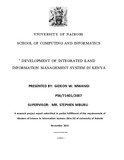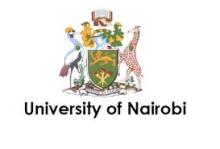Resource information
Land is a key asset of any country. It is one of the factors of production which includes labour
and capital. It is critical for economic, social and political development of a country. There exists
a correlation between proper utilization of land and the economic advancement of a country and
its proper management can only be achieved if information on the said land is available. The
current globalization trend in the world, demand for efficient and effective land services requires
development of an integrated land information management system. Land information is both in
spatial and attribute form. The basics of an integrated land information management system are
the cadastral and land administration systems. These systems playa critical role in collection,
management and dissemination of information about land ownership, use and value. Therefore
an integrated land information management system should address the four key components
which includes; land tenure; land value; land use and land development.
In developing an information system the process involves following a formalized approach to
implement System Development Life Cycle. System Development Life Cycle is composed of
four distinct phases which include planning, analysis, design and implementation. Depending on
whether the emphasis is on business processes or the data that supports business there are various
methodologies or approaches. These models includes; Waterfall Model, Prototype Model,
Throwaway Prototyping Model, Spiral Model, Rapid Application Development Model, Serum
Model, Extreme Programming Model, Object Oriented Model, Dynamic Systems Development
Model, Capability Maturity Model, View model and Unified Process Model. A model that will
be used to develop an integrated land information management system is key in the management
of land. This will ensure the country offers effective and efficient services to its citizens and the
land information produced can be used by the country to make timely and efficient decisions.
In this research, we explored the above models and identified their weaknesses, strengths and
gaps. This was done visa a vis the characteristics of the Integrated Land Information
Management System. We adopted the Unified Process Model for developing the Integrated
Land Information Management System. The main characteristics of this model which includes;
Iterative and Incremental, Use Case Driven, Architecture Centric and Risk Focused were some
of the major points that made us adopt the methodology. Further in selecting the methodology
the following factors were considered: on whether the system has unclear user requirements; the
developer is familiar with the technology to be used; the methodology is complex, reliable; the
schedule of developing and implementing the system i.e., the system is on time, budget and
captures the user's needs.
To find out whether it was appropriate to develop the system and also to identify the user and
system requirements the research methodology used in this research was mainly survey. We
collected data from clients and staff in 10 districts where the land offices are located. The results
of the study showed that both the clients and staffs would like us to develop a system. This
system should be an integrated system and should integrate all the key Ministry services.
To find out whether the adopted model for developing the Integrated Land Information
Management System was appropriate, a prototype of the system was developed and
implemented. This prototype was for Buruburu Block 78 and 79 or Phase IV and V which is
based in Nairobi County. The prototype is a web-based system.
Finally, we identified the various challenges of developing the Integrated Land Information
Management System which includes: Political goodwill, Commitment of Heads of departments,
Establishing a project management team, Change management, Voluminous land records data, Establishing a uniform modem Geodetic Control Network framework and resurveying all the parcels to ensure accuracy and update information, Legal and Institution changes which may affect the handling of data and information, Security of land information both physically and logically, Rapidly changing technology and High cost of developing the system.
The outcome of our research is a prototype that can be implemented in the whole country by the Ministry of Lands.


